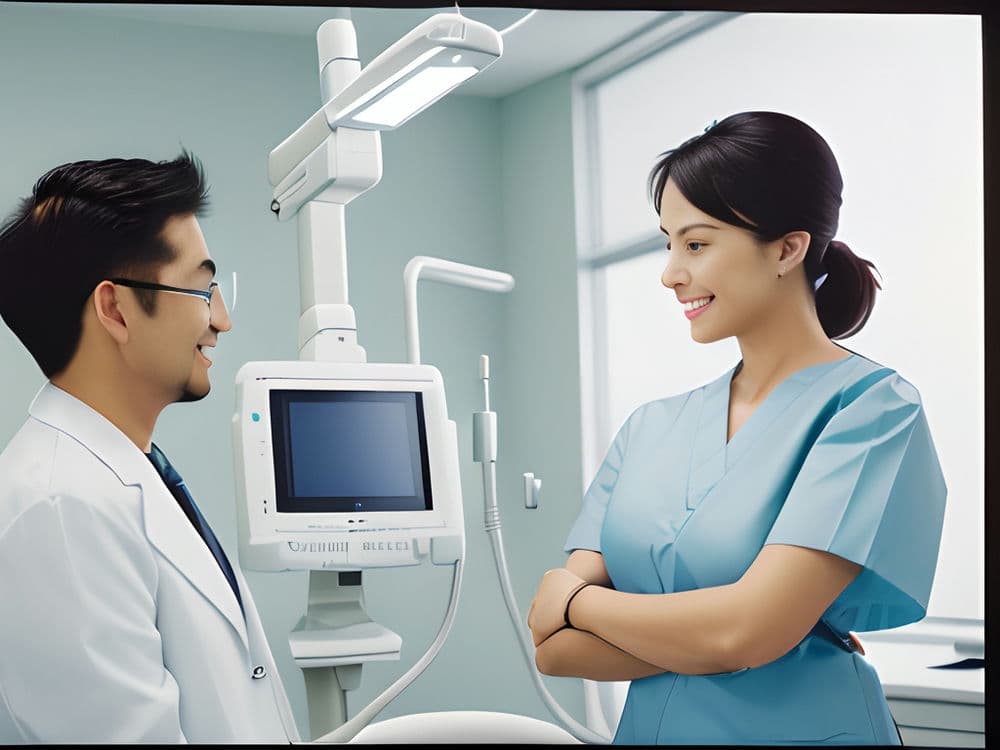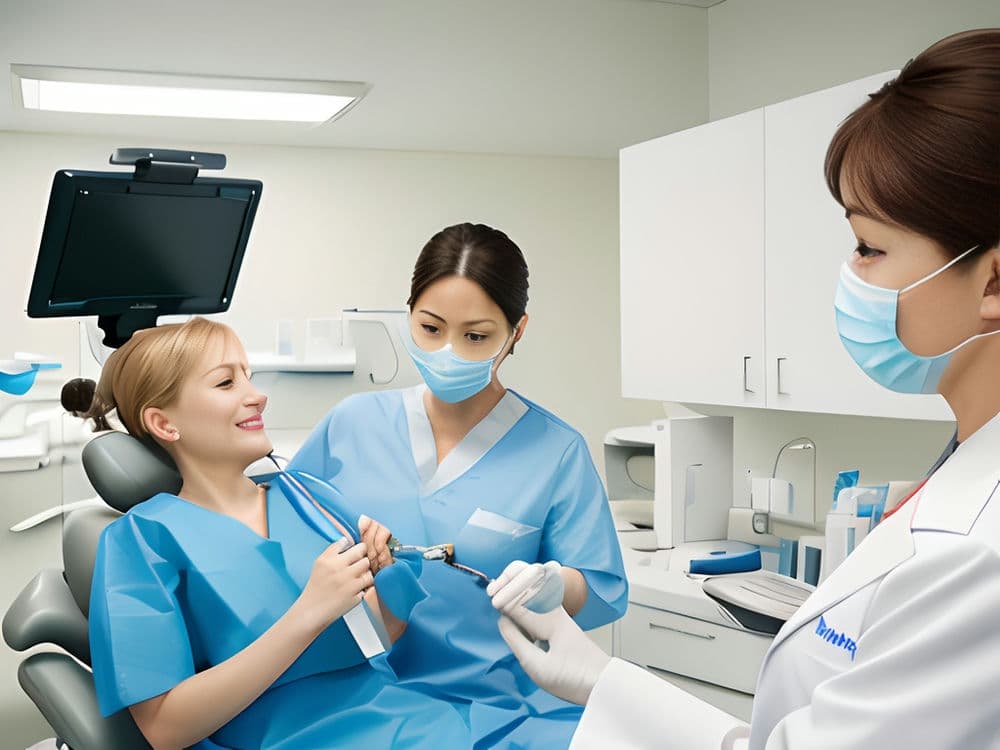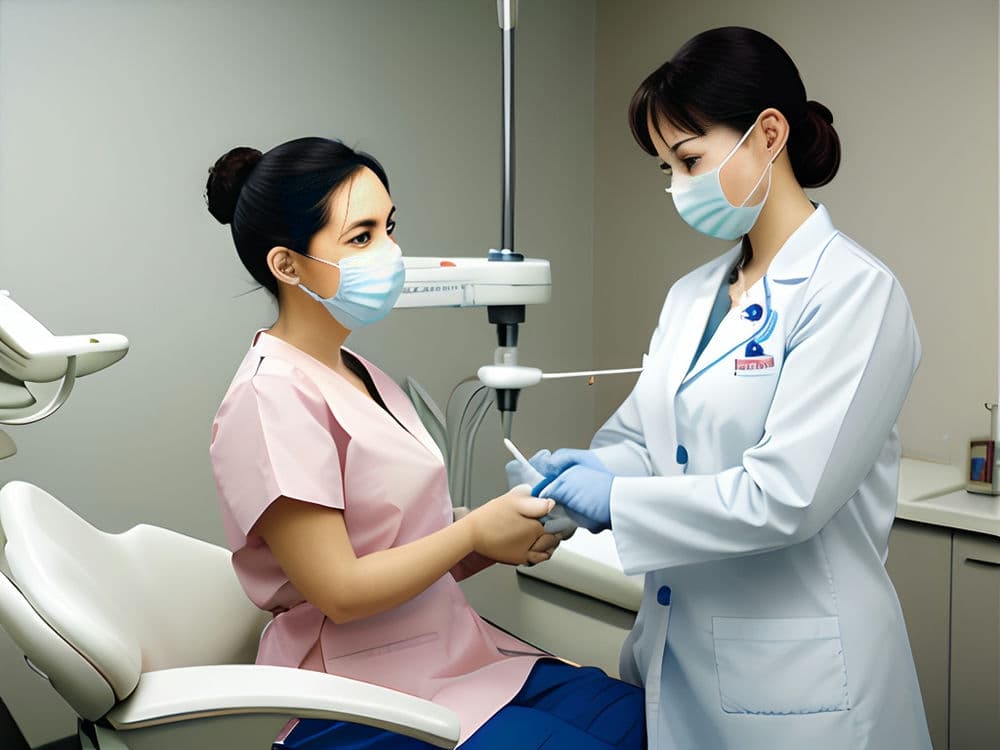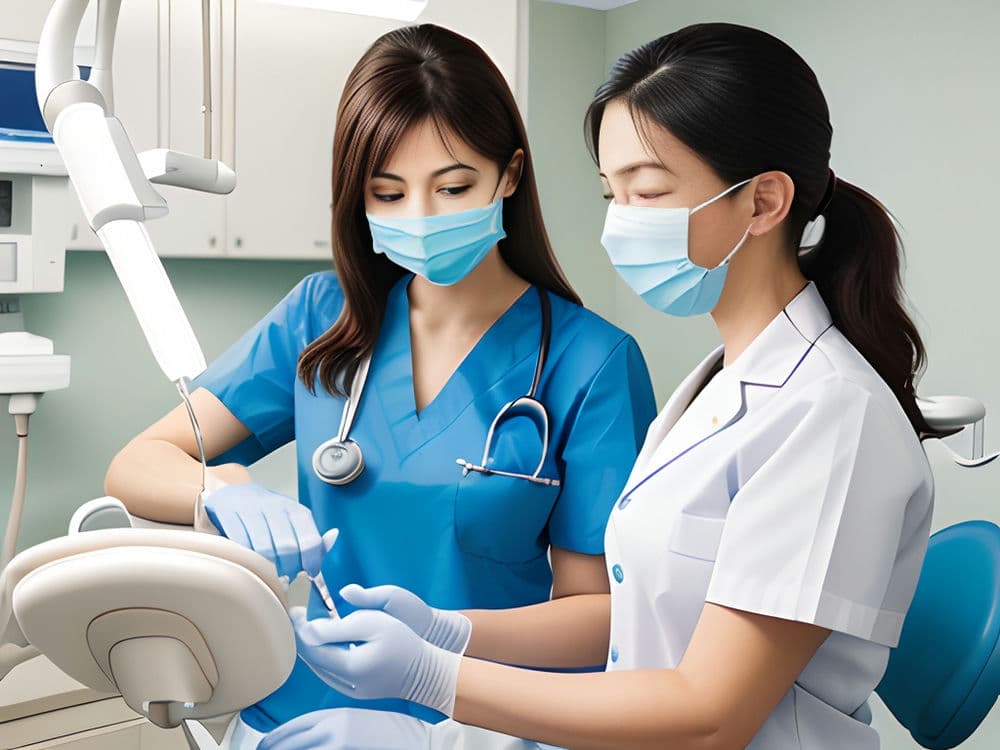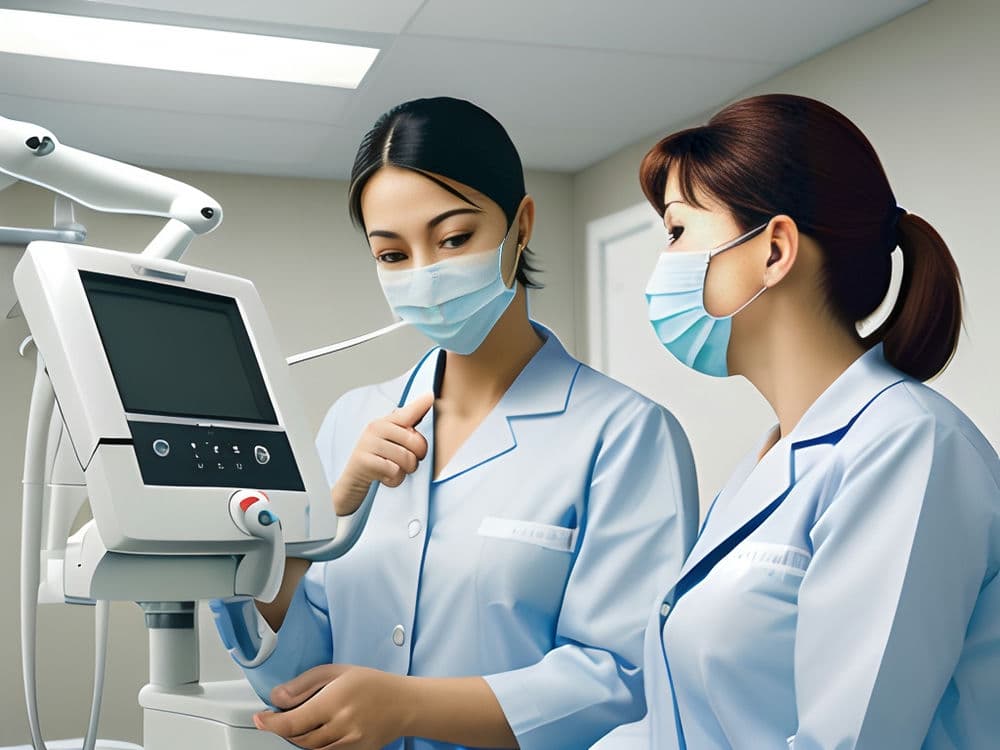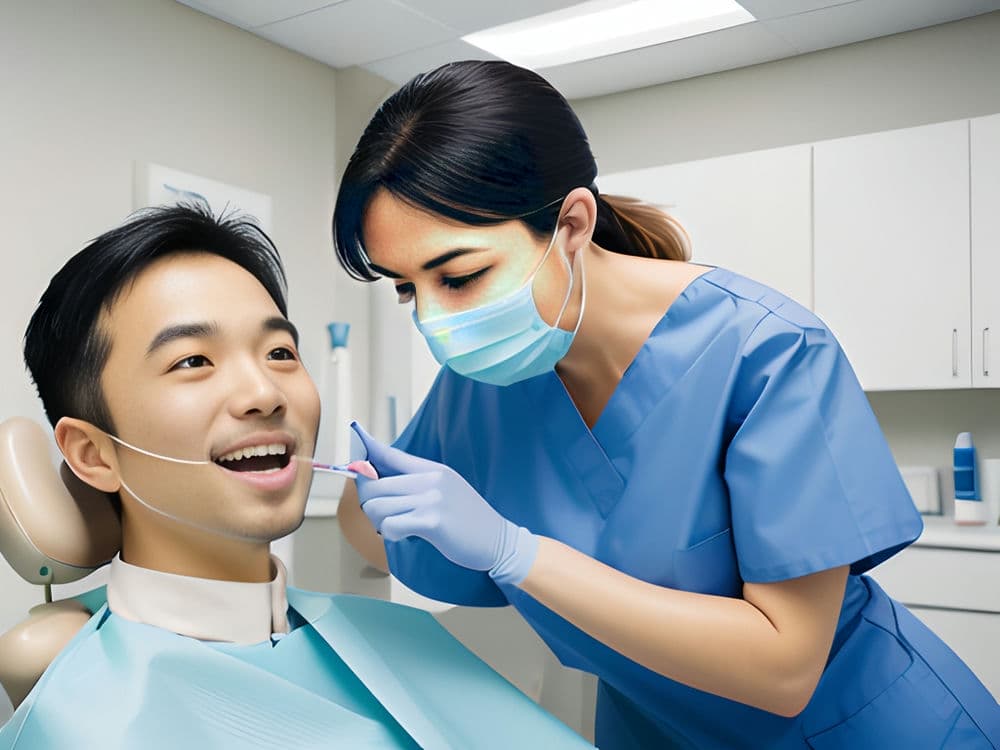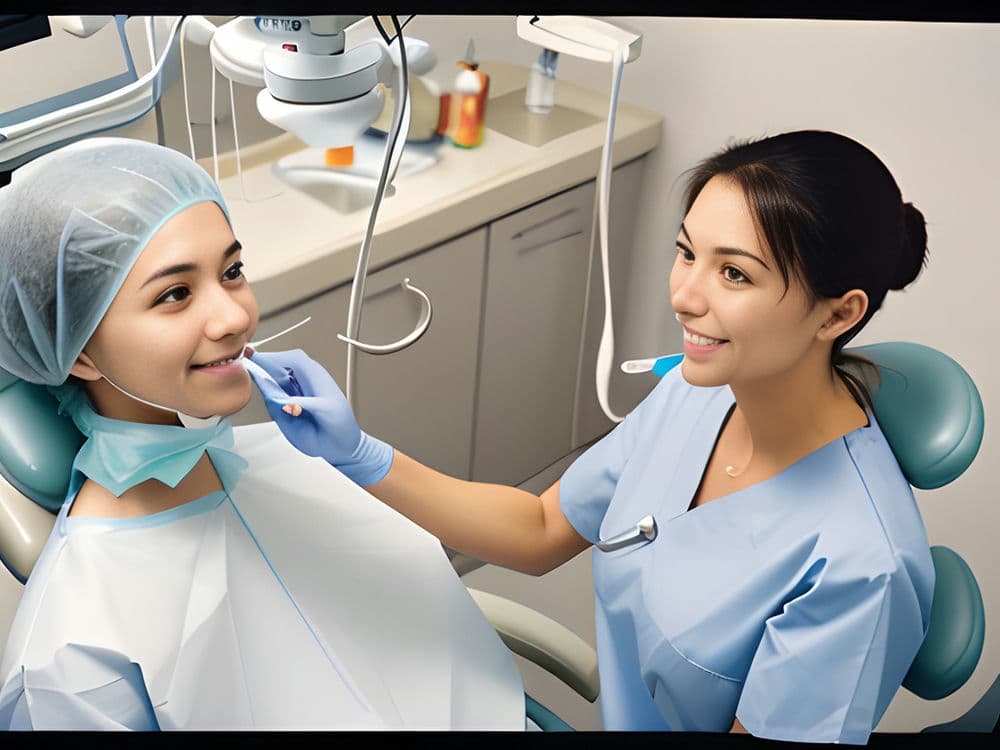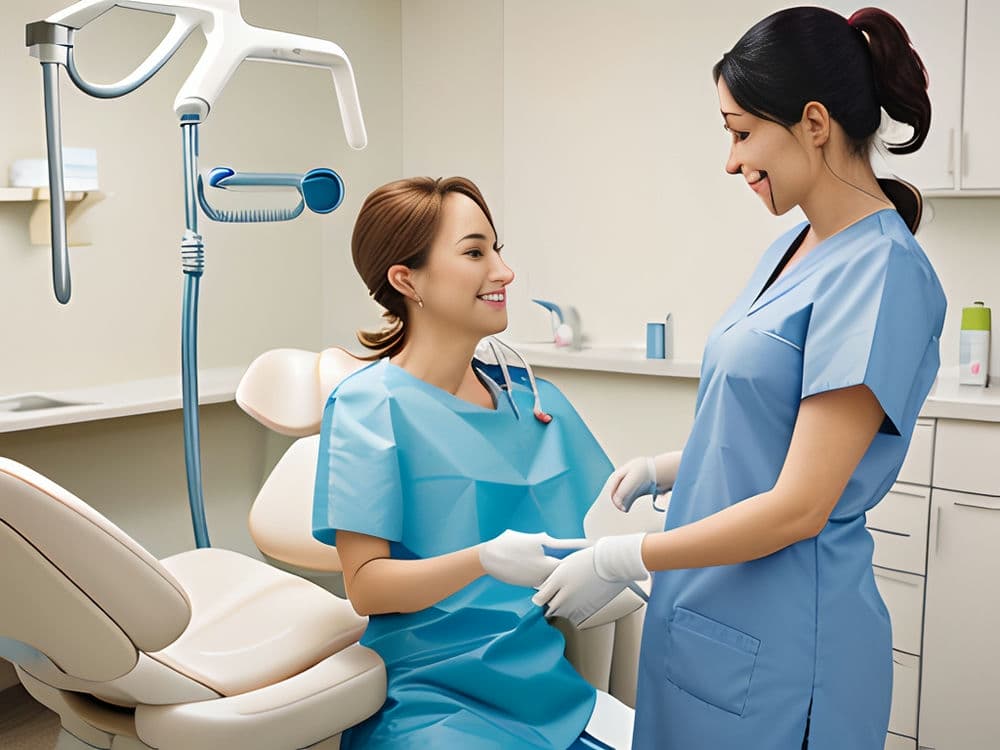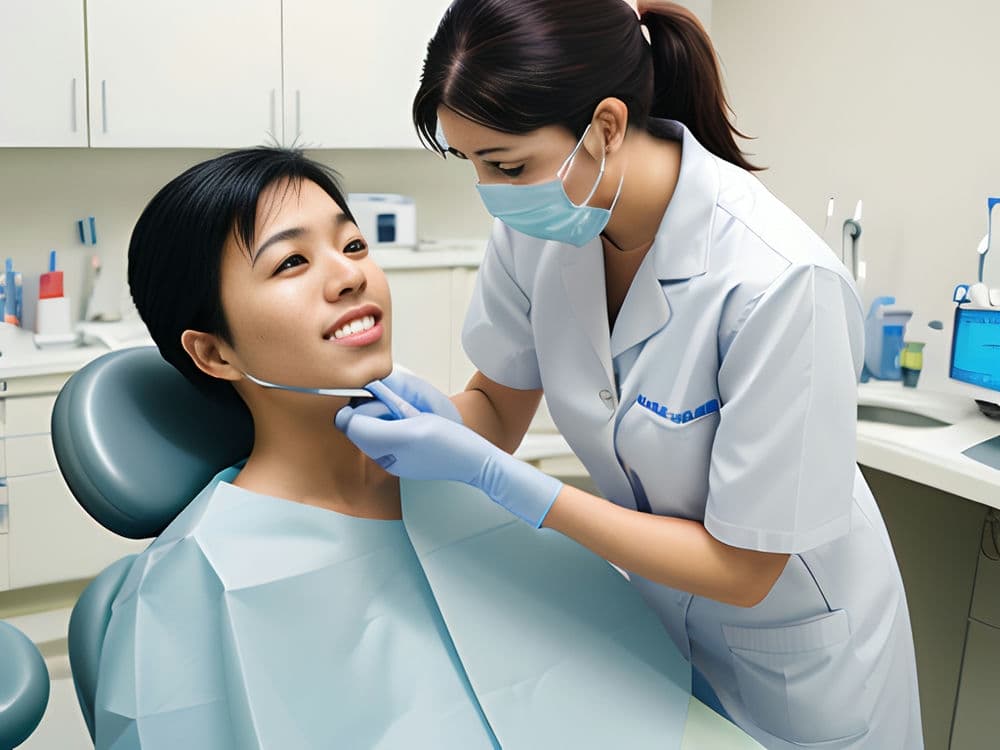In the realm of orthodontic care, traditional metal braces have been a mainstay for correcting misaligned teeth. Although initially associated with discomfort and conspicuousness, recent advances in their design and technology have significantly improved their comfort, aesthetics, and efficiency.
Comfort has been a primary focus for enhancement. Traditional braces were once notorious for causing oral abrasions and discomfort. However, modern adaptations feature smaller brackets and smoother edges that reduce irritation to the inner cheeks and gums. The introduction of heat-activated archwires is another innovation; these wires use body temperature to gently move teeth into place, reducing the overall pressure applied.
When it comes to aesthetics, there has been considerable progress. Metal braces were previously quite noticeable, often leading to self-consciousness among wearers. Today's brackets are substantially less obtrusive and can be fashioned from clear or tooth-colored materials, making them far less visible. Some brands even offer customizable color bands that allow patients to personalize their braces' appearance.
Efficiency in orthodontic treatment is crucial not only for shorter treatment times but also for better outcomes. Advancements in computer modeling and 3D imaging now enable orthodontists to plan treatments with greater precision. This means that each adjustment is more effective at moving teeth towards their optimal position, thus potentially shortening the overall duration of wearing braces.
Furthermore, interdisciplinary collaboration between dental professionals has led to integrated approaches in treating complex cases involving both alignment issues and bite discrepancies. This holistic perspective ensures comprehensive solutions that address functional as well as aesthetic concerns.
Finally, patient education tools have evolved alongside hardware improvements. Interactive apps and software help individuals understand their treatment process better while keeping them engaged throughout the journey towards achieving a perfect smile.
In conclusion, the evolution of traditional metal braces reflects an impressive amalgamation of technological innovation and patient-centered design thinking—a transformation ensuring these time-tested devices remain relevant in today’s fast-paced world of orthodontics where comfort, aesthetics, and efficiency are paramount for patients of all ages seeking healthier smiles.
Orthodontics has long been synonymous with the traditional metal braces that many associate with teenage years. However, recent advancements in dental technology have ushered in an era of innovative alternatives that cater to a wider demographic, ensuring people of all ages can achieve their desired smiles without compromising on aesthetics or comfort.
In particular, clear aligners and ceramic braces have emerged as frontrunners in this orthodontic revolution. Clear aligners, like those offered by Invisalign, are virtually invisible trays made from medical-grade plastic. They are custom-fitted to the patient's teeth and designed to shift teeth incrementally. The discreet nature of these aligners has made them exceedingly popular among adults who might be self-conscious about wearing traditional braces in professional or social settings.
Ceramic braces represent another leap forward. While they function similarly to metal braces, they boast tooth-colored or transparent brackets that blend seamlessly with the natural color of the patient’s teeth. This camouflage effect diminishes the visual impact of the braces, making them a more attractive option for image-conscious individuals.
The rise of these alternatives caters not only to aesthetic preferences but also to comfort and convenience. Clear aligners are removable, allowing for easier eating and cleaning — a significant advantage over fixed braces that can make oral hygiene challenging and limit dietary choices due to food getting trapped.
Moreover, both clear aligners and ceramic braces signify how orthodontic solutions have become more personalized. Advances in 3D imaging and digital treatment planning enable orthodontists to create precise treatment protocols tailored to individual needs, enhancing efficiency and outcomes.
These innovations reflect a broader trend toward patient-centered care within dentistry and underscore an important shift: Orthodontic treatment is no longer just for children or teenagers; it's now accessible and appealing for patients across all walks of life. As research continues and technologies evolve, we can anticipate even more groundbreaking developments that will further expand options for those seeking orthodontic intervention.
In conclusion, the ascendance of clear aligners and ceramic braces marks a pivotal moment in orthodontic care — one characterized by inclusivity, innovation, and a commitment to meeting diverse patient expectations while preserving high standards of effectiveness. These new frontiers in orthodontic solutions promise brighter smiles without the shadows cast by traditional metal brackets — a welcome horizon indeed for individuals looking to enhance their dental health at any age.
In the realm of dental well-being, adult orthodontics emerges as a subfield replete with unique complexities and burgeoning opportunities. Traditionally, orthodontic treatment was primarily associated with adolescents, whose malleable jawbones and teeth responded optimally to corrective procedures. However, recent advancements have obliterated age borders, ushering in an era where individuals at any life stage can aspire for improved dental alignment and functionality.
One prominent challenge in treating adults is that their skeletal maturation has concluded; hence, adjustments necessitate more time and may demand supplemental interventions such as surgery or specialized appliances. Additionally, many adults present with a history of dental restorations or periodontal issues that complicate traditional orthodontic strategies. These scenarios require tailored approaches that respect the integrity of existing dental work while effectively realigning the teeth.
Fortunately, technology's relentless march offers solutions once deemed unattainable. Cutting-edge techniques like three-dimensional imaging provide practitioners with unprecedented diagnostic precision, facilitating the creation of highly personalized treatment plans. Furthermore, discreet options like clear aligners cater to the aesthetic preferences of adult patients who might balk at conventional metal braces due to social or professional considerations.
Another innovative frontier is the integration of interdisciplinary care where orthodontists collaborate closely with periodontists and prosthodontists to address comprehensive oral health needs holistically. This synergy ensures that structural corrections are harmonized with gum health and prosthetic requirements, resulting in not just straighter teeth but also enhanced overall oral function.
In conclusion, although adult orthodontics is fraught with its own set of challenges – from rigid bone structures to complex pre-existing conditions – modern solutions are surging forward to meet these demands head-on. Through technological innovation and multidisciplinary cooperation, today’s orthodontic professionals are equipped more than ever to offer effective treatments that transcend age barriers, allowing all individuals the chance to achieve optimal oral health and confidence in their smiles.
Orthodontics, traditionally associated with the awkward years of adolescence, is evolving. Adults are increasingly seeking ways to refine their smiles without broadcasting their dental journey to the world. Addressing this demographic's distinctive requirements has become a pivotal aspect of modern orthodontic practice.
Gone are the days when metal brackets and wires were the sole option for straightening teeth. Today's innovations offer discrete solutions tailored for adults who wish to maintain a professional image while undergoing treatment. Clear aligners, such as Invisalign, have revolutionized orthodontics with their near-invisibility and removability—appealing features for adults attending business meetings or social gatherings.
Lingual braces take subtlety further by attaching to the back side of teeth, rendering them invisible from outside view. Though technically complex and requiring specialized skills from orthodontists, these devices cater to those who prioritize aesthetics alongside corrective treatment.
Another advance in adult orthodontics is ceramic braces that blend with natural tooth color. While more noticeable than clear aligners or lingual braces, they offer a less conspicuous alternative to traditional metal braces and provide the same level of effectiveness in adjusting misaligned teeth.
Moreover, the advent of digital technology in orthodontics has streamlined treatment planning and monitoring progress. 3D imaging allows practitioners to simulate final outcomes before even beginning treatment, enabling patients to make informed decisions about their care plan. Additionally, remote monitoring technologies permit adjustments without frequent office visits—a convenience highly prized by busy adults.
As we continue exploring new frontiers in orthodontic solutions suitable for all ages, it's clear that embracing patient diversity—including age-specific preferences—is paramount. By providing discreet yet efficient treatments, orthodontists not only enhance smiles but also bolster confidence among adult patients who no longer need compromise professionalism for oral health advancement.
In summary, adult patients today have an array of discreet options at their disposal when it comes to straightening teeth and achieving oral health goals. The industry’s commitment towards innovation reflects an understanding that effective care must be inclusive and adaptable; orthodontic solutions have truly transcended age barriers offering everyone the chance to smile confidently through life's various stages.
Delivering a comprehensive approach to dental care, the integration of orthodontic treatment with restorative procedures is revolutionizing smiles across generations. This symbiotic fusion ensures not only the alignment of teeth through braces or clear aligners but also addresses any decay, damage, or aesthetic concerns that may require fillings, crowns, or implants.
In this new frontier of orthodontic solutions, patients of all ages can benefit from a tailored treatment plan that considers the entire oral landscape. For adults who may have experienced years of wear and tear on their teeth, combining restorative work with orthodontics means they can correct misalignments while simultaneously restoring each tooth to its optimal health and function.
Children and teenagers receiving orthodontic care can also take advantage of restorative techniques. Sealants and fluoride treatments often accompany braces to protect young teeth from decay during the corrective process. In cases where early tooth loss occurs, space maintainers are used to hold the proper gap for permanent teeth, ensuring a seamless transition into an aligned smile.
Furthermore, technological advancements in digital dentistry now allow for precise mapping and customization of both orthodontic appliances and restorative fixtures like crowns or veneers. The result is a more efficient process with outcomes that match each patient's unique dental anatomy and cosmetic desires.
By converging these two disciplines within dentistry, we are witnessing an era where comprehensive care does not simply mean addressing isolated issues as they arise but rather taking a proactive and holistic stance on oral health — crafting smiles that are as beautiful as they are functional.
This integrated approach empowers individuals with confidence at every stage of life. No longer must one choose between straightening their teeth or improving their tooth structure; modern dentistry enables concurrent management for lasting results. It's clear: combining orthodontics with restorative procedures represents a significant leap forward in ensuring complete dental wellness for patients young and old alike.
The integration of digital technologies within the domain of orthodontic treatment planning has revolutionized the way dental professionals approach corrective solutions for patients across diverse age brackets. Traditionally, orthodontists relied on physical impressions and two-dimensional radiographs to diagnose misalignments and devise strategies for intervention. However, with the advent of sophisticated software applications, three-dimensional imaging modalities, and computer-aided design/manufacturing (CAD/CAM) processes, a new era of precision and customization has emerged.
Let's explore how these technological advancements are redefining orthodontics:
1. **Three-Dimensional Imaging:** Technologies such as Cone Beam Computed Tomography (CBCT) allow practitioners to visualize the craniofacial structure in a holistic manner. This comprehensive perspective aids in accurate diagnosis, enabling targeted treatments that account for each patient’s unique anatomy.
2. **Digital Impressions:** Gone are the days of uncomfortable alginate molds. Digital scanners capture oral structures quickly and more comfortably, providing a foundation for virtual treatment plans that can be manipulated and evaluated in real-time.
3. **Computer-Aided Treatment Planning:** With powerful software platforms, orthodontists can simulate tooth movements and predict outcomes with greater certainty before initiating physical procedures. Such foresight not only enhances clinical efficiency but also builds patient trust through visualized end goals.
4. **Custom Appliances:** From braces to aligners, digital technologies facilitate the creation of personalized devices that fit impeccably and work effectively. For instance, Invisalign aligners are custom-fabricated using 3D printing technology based on individual treatment plans derived from digital scans.
5. **Remote Monitoring:** With teledentistry tools like smartphone apps equipped with artificial intelligence, patients can now have their progress monitored remotely by their orthodontist. This convenience minimizes clinic visits while ensuring adherence to treatment protocols.
6. **Interdisciplinary Collaboration:** Digital records can be easily shared among different specialists involved in a patient's care plan—be it an oral surgeon or periodontist—streamlining communication and collaborative efforts toward optimal clinical outcomes.
In conclusion, integrating digital technologies into orthodontic treatment planning presents numerous benefits: enhanced diagnostic accuracy; tailor-made appliances; efficient workflows; improved patient engagement; remote monitoring capabilities; plus interdisciplinary synergy—all contributing to effective solutions tailored for individuals irrespective of age categories or complexity levels of dental issues encountered.
Orthodontic treatment has undergone a significant transformation with the advent of advanced technologies. By leveraging 3D imaging, digital models, and virtual simulations, orthodontists are now able to achieve precise outcomes that were once unimaginable. These new frontiers in orthodontic solutions benefit patients of all ages, offering personalized treatment plans tailored to each individual's unique dental anatomy.
The journey towards a perfect smile often begins with detailed 3D images of a patient’s mouth. Unlike traditional two-dimensional x-rays, 3D imaging provides a comprehensive view of the teeth, jawbone, and surrounding tissues. This allows orthodontists to assess complex cases with greater accuracy and plan interventions that minimize potential complications.
Digital models serve as the next step in this technological evolution. Created from scans of a patient's teeth, these models replace the need for uncomfortable plaster molds. They can be manipulated on-screen to predict how teeth will move over time, enabling practitioners to devise more effective treatment strategies.
Perhaps most revolutionary is the use of virtual simulations. With this tool, both orthodontists and patients can visualize the end results before any physical adjustments are made to the teeth. Such foresight ensures that final outcomes align closely with expectations and reduces anxiety about undergoing orthodontic procedures.
These innovations not only improve precision but also enhance comfort and convenience for patients. For instance, clear aligners designed through digital modeling fit snugly over teeth and are nearly invisible when worn—appealing features especially for adult patients concerned about aesthetics.
Moreover, by simulating different treatment paths virtually, healthcare providers can make informed decisions without resorting to trial-and-error methods that extend treatment times and discomfort for patients.
In conclusion, the integration of 3D imaging, digital models, and virtual simulations into orthodontics represents a considerable leap forward in dental care. Through these technologies' capabilities to forecast accurate results tailored specifically per individual case—whether it be for children or adults—orthodontic treatments have become more efficient, less invasive, and far better suited to meet diverse needs across all age groups.
In the realm of orthodontics, the integration of computer-guided treatments has heralded a new era of precision and efficiency. These advanced solutions employ cutting-edge technology to streamline procedures for patients across all age groups. The use of digital planning tools and 3D imaging in particular has significantly reduced treatment durations while simultaneously enhancing outcome accuracies.
One primary benefit is the reduction in overall treatment time. Traditionally, orthodontic assessments were reliant on manual techniques that not only consumed considerable time but were also prone to human error. Computer-guided systems have revolutionized this process by allowing for rapid data acquisition and analysis, thus fast-tracking diagnosis and the creation of treatment plans. For instance, with clear aligners, custom treatment protocols can be devised swiftly, facilitating quicker commencement of the corrective process.
Accuracy improvement stands as another pivotal advantage offered by these modern interventions. Computers excel in delivering precise calculations and movements required for effective orthodontic care. This level of exactness ensures that each adjustment is executed with optimal force and directionality, promoting more predictable tooth movement and reducing the likelihood of unforeseen complications or revisions during treatment.
For patients spanning various ages – from children to adults – these technological advancements translate into less intrusive and more comfortable experiences. Children especially benefit as their developing dentition can be monitored meticulously, enabling timely interventions that are less distressing than traditional braces might be. Adults appreciate the inconspicuous nature of treatments like Invisalign which aligns teeth discreetly without broadcasting one's orthodontic journey to the world.
Furthermore, computer-aided treatments facilitate better patient education by providing visual simulations of expected outcomes before starting therapy; this enhances understanding and engagement with the treatment plan.
In conclusion, computer-guided technologies in orthodontics offer substantial benefits through time savings and accuracy enhancements. They represent a leap forward in customized care that caters adeptly to patients' unique needs irrespective of age, making strides towards more efficient and effective orthodontic solutions for all who seek them.
Interdisciplinary approaches to complex orthodontic cases involve integrating multiple fields of expertise, ensuring comprehensive solutions tailored for individuals at any life stage. This holistic strategy transcends traditional boundaries, enabling practitioners to address the intricate web of factors affecting dental alignment and oral health.
Orthodontics has long been synonymous with adolescence, yet today's innovations reveal that effective treatments are accessible for all ages. With advancements in technology and a deeper understanding of craniofacial development, we're witnessing the dawn of new possibilities that cater to the unique anatomical and physiological needs across one's lifespan.
Collaboration is pivotal; orthodontists now routinely partner with maxillofacial surgeons, periodontists, speech therapists, and even nutritionists to devise multifaceted treatment plans. Such synergy allows for not only straightening teeth but also resolving issues from sleep apnea to temporomandibular joint disorders.
Customization is another frontier being conquered. 3D imaging and printing technologies have revolutionized appliance design, creating devices that are not just more comfortable but exceedingly precise. These tools enable clinicians to predict outcomes with greater accuracy, reducing treatment times and enhancing patient experiences.
Furthermore, there’s an increasing emphasis on non-invasive techniques. For instance, clear aligners offer an aesthetic alternative to braces suitable for many age groups while low-level laser therapy presents a novel way to accelerate bone remodeling during orthodontic treatment.
In summary, embracing interdisciplinary approaches opens up new frontiers in orthodontic solutions for patients of every age. By harnessing diverse expertise and cutting-edge technologies, we can craft individualized care pathways that yield optimal functional and esthetic results—ushering in a future where everyone has access to smile-enhancing therapies regardless of their season in life.
Embarking on a journey through the innovative realm of orthodontics, one discovers that treatment is no longer confined to the traditional braces of yesteryear. Today's multidisciplinary approach unites periodontists, oral surgeons, and orthodontists in a collaborative dance to create custom solutions that cater to patients at any stage of life.
The integration of these dental specialists opens up new frontiers in patient care, allowing for more comprehensive planning and execution of treatment plans. Periodontists bring to the table their expertise in the health and treatment of gums and bone—foundational elements crucial for successful orthodontic outcomes. Their role becomes increasingly important when considering adult patients, who may face complex challenges such as periodontal disease or bone loss.
Oral surgeons step into this collaborative framework with their surgical prowess, making possible procedures like tooth extractions and jaw surgeries that can optimize the canvas on which orthodontics will work its magic. For cases where teeth are overcrowded or where the jaw needs realignment, oral surgery can be a game-changer that paves the way for more effective orthodontic treatment.
Orthodontists themselves have long been architects of smiles but now function within an enriched team environment. They align teeth and jaws using an array of devices from traditional braces to cutting-edge clear aligners. However, by joining forces with periodontists and oral surgeons, they're able to tackle more complex issues with greater precision.
This synergy between disciplines does not merely enhance results aesthetically; it also promotes better overall oral health. By addressing gum health before straightening teeth, ensuring proper bite alignment through surgery if necessary, and then meticulously moving teeth into place, patients receive comprehensive care that considers every aspect of their dental well-being.
Moreover, this integrated approach benefits all ages—children whose jaws are still developing can have growth guided appropriately; teenagers can enjoy innovations like Invisalign Teen; adults who once thought they were past the point of correction can now find hope in these collaborative strategies.
In conclusion, as we gaze upon these new frontiers in orthodontics illuminated by teamwork among dental professionals—a horizon once distant now lies within grasp. Through collaboration comes transformation: healthier mouths and brighter smiles for individuals young and old alike. The future shines bright on this path paved by unity among those dedicated to perfecting our grins—one strategic partnership at a time.
Case studies often illuminate the remarkable potential of interdisciplinary approaches in advancing orthodontic treatments. These collaborative efforts have led to groundbreaking solutions that cater to patients of all ages, reflecting a shift from traditional methods to more innovative and inclusive practices.
One such example involves the integration of 3D printing technology with orthodontics. A study detailed the journey of an adolescent patient presenting with complex malocclusion. The traditional solution would typically involve braces or invasive surgery. However, through the collaboration of engineers, orthodontists, and material scientists, a custom set of 3D-printed aligners was created. This not only reduced treatment time but also enhanced comfort and aesthetic appeal for the young patient.
Another case highlights the synergy between genetics and orthodontics. A geriatric patient suffering from age-related dental deterioration experienced difficulty using conventional dentures due to bone loss in their jaw. Interdisciplinary cooperation led to a novel approach using genetic screening to identify optimal sites for mini-implant-supported overdentures. This personalized strategy resulted in improved masticatory function and overall quality of life for the senior individual.
Pediatric sleep apnea—a condition traditionally managed by pediatricians or ENT specialists—has also benefited from an interdisciplinary approach involving orthodontists. In one instance, continuous positive airway pressure (CPAP) machines were ineffective for a child due to non-compliance issues. Orthodontists stepped in with a custom-designed oral appliance that repositioned the jaw during sleep, promoting airflow and resolving apnea episodes without reliance on cumbersome machinery.
These cases demonstrate how blending expertise across fields can lead to inventive solutions that transcend age barriers in orthodontics. Such success stories underscore not just clinical advancements but also a commitment to holistic care that addresses unique needs while pushing forward new frontiers in dental medicine.
In the realm of orthodontic treatment, a paradigm shift is underway as we transition toward patient-centric care models. This approach places the individual needs and experiences of patients at the forefront of dental practices, leading to more personalized and effective treatments for people across all age groups.
Traditionally, orthodontics has been viewed through a rather uniform lens, with a one-size-fits-all mentality that often overlooked the unique circumstances and preferences of each patient. However, technological advancements and a growing appreciation for tailored healthcare are driving the development of new frontiers in orthodontic solutions.
Embracing patient-centric care involves a multidimensional strategy that considers not only the alignment of teeth but also the overall well-being and lifestyle of patients. It requires open communication between orthodontists and their clients, ensuring that treatment plans are fully understood and aligned with patients' expectations.
Digital technologies such as 3D imaging and computer-aided design have revolutionized how orthodontists plan treatments, allowing them to simulate outcomes and adjust procedures according to specific patient anatomy. Moreover, clear aligners offer an aesthetic alternative to traditional braces that appeals to adults seeking discreet correction options.
For children and teenagers whose jaws are still developing, early intervention using growth modification techniques can lead to better results with shorter treatment times. Likewise, older adults benefit from less invasive options that consider their dental history and potential bone density issues.
The integration of interdisciplinary care teams is another aspect of this patient-centered model. By collaborating with other healthcare professionals like speech therapists or maxillofacial surgeons when necessary, orthodontists can address complex cases holistically.
Ultimately, embracing patient-centric care models in orthodontics ensures that treatments are not only technically successful but also enhance quality of life by respecting personal needs—marking a new era where every smile reflects an understanding that healthcare is most impactful when it's tailored to the individual.
Orthodontics has traditionally been associated with the iconic image of teenagers sporting metal braces. However, with advancements in dental technology and a deeper understanding of patient needs, orthodontic solutions have transcended age boundaries and are now adept at catering to individuals across the lifespan.
New Frontiers in Orthodontic Solutions for All Ages - Bandcamp
- periodontology
- surgeon
- pediatrics
In this era of personalized medicine, tailoring treatment plans to accommodate individual lifestyles, expectations, and financial capabilities has become paramount. The one-size-fits-all approach is an antiquated concept; today's orthodontic treatments are as diverse as the patients seeking them.
Adults juggling work commitments and social engagements might find traditional braces cumbersome. For them, inconspicuous options such as clear aligners or lingual braces that attach behind the teeth offer an appealing solution. These discreet methods enable adults to undergo treatment without feeling self-conscious about their appearance.
For children and teenagers with active lifestyles involved in sports or other extracurricular activities, durability becomes a key concern. Here, more robust options like ceramic braces or newer-generation metal braces designed to withstand physical activity can be considered.
Patient expectations also play a critical role in treatment planning. Some may prioritize speed and are willing to opt for accelerated orthodontics despite potential discomfort. Others might value comfort over duration, leaning towards gentler approaches even if they take longer to achieve results.
Financial capabilities cannot be overlooked when discussing orthodontic solutions. Not all patients can afford expensive treatments; thus, it's essential for orthodontists to provide a range of options at various price points. This could include traditional metal braces as a cost-effective choice or payment plans that make more advanced treatments accessible over time.
Moreover, advancements such as teledentistry have opened new frontiers in patient convenience and accessibility—allowing for remote monitoring of progress and reducing the frequency of in-office visits—a boon for those with demanding schedules or limited access to care.
In conclusion, modern orthodontics offers an array of customizable solutions that honors each individual's unique situation. By considering lifestyle compatibility, meeting personal expectations, and respecting financial constraints, we ensure that high-quality orthodontic care is not just a privilege but a possibility for everyone—regardless of age.
In the realm of orthodontic solutions, a paradigm shift has been observed that transcends mere dental alignment. It is now widely acknowledged that the journey towards a perfect smile should enrich the patient's experience through thoughtful communication, comprehensive education, and dynamic engagement initiatives. These elements form the cornerstone of modern orthodontic practices catering to individuals across various age groups.
Effective communication stands as a pillar in enhancing patient satisfaction. Orthodontists and their teams are trained not only in clinical skills but also in interpersonal interactions that foster trust and clarity. By adopting an empathetic approach and actively listening to patients' concerns, practitioners can tailor their treatment plans accordingly. This inclusive dialogue helps demystify complex procedures, reducing anxiety and setting realistic expectations for outcomes.
Education is another powerful tool in this transformative process. Knowledge empowerment enables patients to make informed decisions about their care. Clear explanations of treatment options, potential risks, benefits, and maintenance strategies equip them with the confidence to engage proactively in their orthodontic journey. Moreover, educational resources such as brochures, models, and digital simulations can help elucidate what might otherwise be abstract concepts.
Engagement extends beyond passive reception of information; it involves active participation of patients in their own treatment progression. Innovative technologies like apps for tracking aligner wear-time or virtual platforms for remote monitoring have revolutionized patient involvement. They offer convenience while encouraging adherence to treatment protocols which ultimately enhances clinical outcomes.
Community outreach programs can also play a significant role in engagement by heightening awareness about oral health within broader society contexts. Seminars at schools or community centers serve as platforms where orthodontists share insights into early intervention strategies or dispel myths related to braces among adolescents or adults alike.
Importantly, these initiatives must evolve with changing demographics and technological advancements to remain relevant and effective. Personalizing experiences through data-driven insights allows for continual refinement of patient care strategies—thus ensuring that every individual feels valued throughout their transformational path toward optimal dental health.
In conclusion, integrating communication tactics with educational materials and fostering participatory engagement creates a supportive environment conducive to successful orthodontic treatments regardless of age. This holistic approach not only aims at achieving functional bite correction but also ensures an overall positive healthcare encounter—a testament to how far-reaching impacts on lives extend well beyond mere aesthetics.
The realm of orthodontics stands poised on the brink of a transformative era, marked by technological advances and innovative approaches that promise to redefine dental care for individuals across the lifespan. As we peer into the future, it becomes evident that novel orthodontic solutions will cater not only to the traditional adolescent demographic but to patients of every age.
Historically, braces have been predominantly associated with teenagers, their metallic gleam a rite of passage into adulthood. However, modern trends indicate an increasing number of adults seeking orthodontic intervention — driven by desires for improved aesthetics and oral health. This shift has spurred the development of subtler, more sophisticated appliances like clear aligners, lingual braces hidden behind teeth, and ceramic brackets that blend seamlessly with natural enamel.
Innovation in material science plays a pivotal role in this evolution. Space-age materials such as nickel-titanium alloys exhibit properties ideal for gentle and efficient tooth movement. Moreover, biocompatible polymers used in clear aligner technology are revolutionizing treatment by offering a virtually invisible method to correct malocclusions.
Digital technology is another cornerstone heralding change within orthodontics. Three-dimensional imaging and computer-aided design/computer-aided manufacturing (CAD/CAM) allow for unprecedented precision in diagnosis and appliance fabrication. These tools enable tailored treatment plans that honor the unique contours of each patient's oral landscape.
Robotics and artificial intelligence are set to further disrupt conventional practices. Robots may soon assist in placing brackets with exacting accuracy or even perform adjustments remotely controlled by experienced practitioners. AI algorithms can analyze vast datasets from completed treatments to predict optimal pathways for tooth movement, thereby reducing treatment times and improving outcomes.
Advances extend beyond hardware; there is burgeoning interest in interceptive orthodontics — intervening at earlier stages when children are still growing to guide jaw development favorably and possibly obviate the need for more extensive treatment later on.
Gene editing technologies such as CRISPR hold tantalizing potential — imagine if genetic predispositions towards malocclusion could be identified and addressed before they manifest physically? While ethical considerations abound, such prospects underscore how interdisciplinary collaboration might shape future therapies.
As we look ahead at the horizon of orthodontics' future, it's apparent that integration will be key: integration of new technologies with existing protocols; integration across disciplines yielding holistic strategies; integration of personalized care accommodating all ages gracefully into our journey towards optimal oral health.
With each stride forward along these new frontiers comes an expanded understanding that orthodontic care does not merely straighten teeth but contributes significantly to overall well-being — affirming its value as an integral component of healthcare's broader tapestry as we venture into tomorrow's possibilities together.
Orthodontics, the dental specialty concerned with correcting teeth and jaw alignment, is experiencing a renaissance of innovation. Traditionally centered on braces and mechanical adjustments, the field is now embracing cutting-edge technologies to enhance patient outcomes across all age groups.
Gene therapy emerges as one of these new frontiers. By targeting the genetic underpinnings of tooth movement and bone remodeling, researchers aim to revolutionize treatment plans. Imagine a future where orthodontic conditions are not just managed but cured at their molecular roots. Such advancements could significantly reduce treatment durations and improve long-term stability.
Tissue engineering also presents exciting potential in orthodontics. Current research focuses on regenerating bone and periodontal structures that support teeth, laying the groundwork for more comprehensive corrective procedures. This bioengineering approach might one day allow for the growth of new, perfectly aligned teeth as replacements for those that are lost or irreparably damaged.
Robotics introduces precision and customization previously unattainable in orthodontic care. With robotic assistance, treatments can be meticulously planned and executed with unparalleled accuracy. These technologies promise to minimize human error and optimize patient-specific treatment paths, resulting in better outcomes with less discomfort.
As we explore these ongoing areas of research—gene therapy, tissue engineering, robotics—we find ourselves at the cusp of an era where orthodontic solutions transcend traditional limitations. The promise lies not only in perfecting smiles but also in offering enduring health benefits tailored to individuals of every age.
The realm of orthodontics is on the cusp of a revolution, thanks to the rapid advancement in emerging technologies, which are poised to redefine practice standards and expand treatment possibilities for patients across all age groups. As we gaze into this future landscape, it's crucial to anticipate and prepare for the transformative effects these innovations will have on orthodontic care.
One significant frontier is the development of smart braces. These devices, embedded with sensors, can monitor tooth movement and pressure exertion in real-time, providing feedback that can be used to adjust treatments dynamically. This means that instead of having a standard treatment plan based on estimated progressions, each patient’s experience could become highly personalized and optimized for quicker results.
Furthermore, 3D printing technology has begun infiltrating orthodontics with the potential to dramatically alter how appliances are created. It enables practitioners to produce custom-fitted braces and retainers efficiently in-house. This not only shortens waiting times but also increases the precision fitment of orthodontic devices, enhancing comfort and potentially improving outcomes.
Artificial intelligence (AI) stands as another groundbreaking force. AI algorithms can now analyze dental images more quickly than ever before while identifying patterns that might escape human detection. In time, AI could assist in crafting individualized treatment plans by predicting tooth movements more accurately than current methods allow.
Additionally, teledentistry has surged forward recently due to necessity from global health challenges. Virtual consultations and remote monitoring have become more prevalent, ensuring continuity of care when face-to-face appointments aren't possible or practical. Teledentistry broadens access to specialist advice regardless of geographical constraints and could play an ongoing role in post-treatment monitoring.
Lastly, advances in biotechnology may soon enable us to manipulate tooth positioning at a molecular level through pharmacological means—potentially reducing or even eliminating the need for mechanical devices like braces or aligners altogether.
In conclusion, anticipating these technological shifts is vital for contemporary orthodontists who must stay abreast with innovation while upholding ethical considerations related to efficacy and patient safety. Preparing oneself through continuous education ensures readiness as new frontiers open up in delivering efficient orthodontic solutions tailored adeptly towards every age bracket's unique needs.
